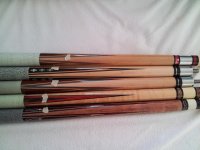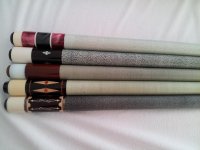I was sitting around today and did something I've been meaning to do for a while, but never got around to it. I wanted to see the difference and compare the balance points on a few of my cues that I play with.
The two on the bottom are McDermotts of different weights, different woods, and joint sizes and diameters (a C-14 and a RS-11). One is over 35 years old and the other is over 20). The balance points on these cues came out almost identical.
The Titlist cue on top is over 40-something years old and it is full-spliced and shows the balance point with a new 14mm shaft attached. It moves a bit back down when I put the original shafts on it, which are a bit less than 13mm, but have steel collars.
The second cue from the top is a Hall of Fame cue made by Adam Japan and it has the same balance point as the third cue which is a full-splice Titlist that is over 60 years old.
All of the cues are almost identical in butt length and the shaft lengths may vary just a little bit. Some of the shafts are a bit longer than the others, but no more than an inch at the very most.
What does all of this mean, besides I have too much time on my hands?
It means that when using all of the different cues, you have to change something in your stroke length or bridge length in order for them all to feel the same balance in your hands.
When I consistently play with the same cue, I know immediately where on the shaft I need to put my bridge hand and my grip hand on the cue to feel the exact balance before I even pick up the cue.
When I switch cues, it takes my mind and body a while to get back into tune for that particular cue.
That is why I recommend that people find a cue that they like and get used to it instead of changing cues all the time. Once you know your cue and yourself, you will play much better. It usually isn't the cue's fault.
The two on the bottom are McDermotts of different weights, different woods, and joint sizes and diameters (a C-14 and a RS-11). One is over 35 years old and the other is over 20). The balance points on these cues came out almost identical.
The Titlist cue on top is over 40-something years old and it is full-spliced and shows the balance point with a new 14mm shaft attached. It moves a bit back down when I put the original shafts on it, which are a bit less than 13mm, but have steel collars.
The second cue from the top is a Hall of Fame cue made by Adam Japan and it has the same balance point as the third cue which is a full-splice Titlist that is over 60 years old.
All of the cues are almost identical in butt length and the shaft lengths may vary just a little bit. Some of the shafts are a bit longer than the others, but no more than an inch at the very most.
What does all of this mean, besides I have too much time on my hands?
It means that when using all of the different cues, you have to change something in your stroke length or bridge length in order for them all to feel the same balance in your hands.
When I consistently play with the same cue, I know immediately where on the shaft I need to put my bridge hand and my grip hand on the cue to feel the exact balance before I even pick up the cue.
When I switch cues, it takes my mind and body a while to get back into tune for that particular cue.
That is why I recommend that people find a cue that they like and get used to it instead of changing cues all the time. Once you know your cue and yourself, you will play much better. It usually isn't the cue's fault.


